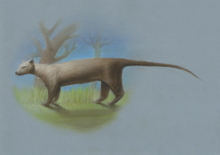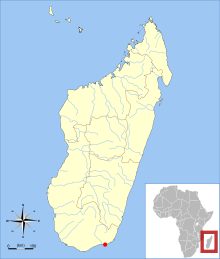Our website is made possible by displaying online advertisements to our visitors.
Please consider supporting us by disabling your ad blocker.
Portal:Madagascar
The Madagascar Portal
Madagascar, officially the Republic of Madagascar, is an island country that includes the island of Madagascar and numerous smaller peripheral islands. Lying off the southeastern coast of Africa, it is the world's fourth largest island (after Greenland, New Guinea, and Borneo), the second-largest island country (after Indonesia), and the 46th largest country overall. Its capital and largest city is Antananarivo. Following the prehistoric breakup of the supercontinent Gondwana, Madagascar split from Africa during the Early Jurassic period, around 180 million years ago, and separated from the Indian subcontinent approximately 90 million years ago. This isolation allowed native plants and animals to evolve in relative seclusion; as a result, Madagascar is a biodiversity hotspot and one of the world's 17 megadiverse countries, with over 90% of its wildlife being endemic. The island has a subtropical to tropical maritime climate. Madagascar was first permanently settled during or before the mid-first millennium AD by Austronesian peoples, presumably arriving on outrigger canoes from present-day Indonesia. These were joined around the ninth century AD by Bantu groups crossing the Mozambique Channel from East Africa. Other groups continued to settle on Madagascar over time, each one making lasting contributions to Malagasy cultural life. Consequently, there are 18 or more classified peoples of Madagascar, the most numerous being the Merina of the central highlands. Until the late 18th century, the island of Madagascar was ruled by a fragmented assortment of shifting sociopolitical alliances. Beginning in the early 19th century, most of it was united and ruled as the Kingdom of Madagascar by a series of Merina nobles. The monarchy was ended in 1897 by the annexation by France, from which Madagascar gained independence in 1960. The country has since undergone four major constitutional periods, termed republics, and has been governed as a constitutional democracy since 1992. Following a political crisis and military coup in 2009, Madagascar underwent a protracted transition towards its fourth and current republic, with constitutional governance being restored in January 2014. (Full article...) This is a Featured article, which represents some of the best content on English Wikipedia..
 Cryptoprocta spelea, also known as the giant fossa, is an extinct species of carnivore from Madagascar in the family Eupleridae which is most closely related to the mongooses and includes all Malagasy carnivorans. It was first described in 1902, and in 1935 was recognized as a separate species from its closest relative, the living fossa (Cryptoprocta ferox). C. spelea was larger than the fossa, but otherwise similar. The two have not always been accepted as distinct species. When and how C. spelea became extinct is unknown; there is some anecdotal evidence, including reports of very large fossas, that there is more than one surviving species. (Full article...) Selected article -Women in Madagascar generally live longer than men, whom they outnumber. Marrying young, they are traditionally subservient to their husbands. Roughly a third have their first child before the age of 19, and those who wish to delay having children may not have access to contraceptives. Although it is illegal with no exceptions, abortion is common, with an estimated 24 percent of women having had one. While they are constitutionally equal to men, they have unequal property rights and employment opportunities in certain areas. (Full article...) This is a Good article, an article that meets a core set of high editorial standards.
Microgale macpheei is an extinct shrew tenrec from southeastern Madagascar. It is known only from two partial skulls found in Andrahomana cave, which radiocarbon dating of associated rodent remains suggests are about 3000 years old. It is the only known recently extinct tenrec. First described in 2007, it is most similar to the smaller Microgale brevicaudata of northern and western Madagascar. M. macpheei has a broad rostrum (front part of the skull) and, like M. brevicaudata, lacks a diastema (gap) between the premolars. A number of details of tooth morphology are characteristic of M. macpheei. (Full article...) General images -The following are images from various Madagascar-related articles on Wikipedia.
Selected panoramaRice fields near Ambalandingana, Madagascar.
TopicsCategoriesSelected pictureAssociated WikimediaThe following Wikimedia Foundation sister projects provide more on this subject:
Discover Wikipedia using portals | |||
Previous Page Next Page















































































